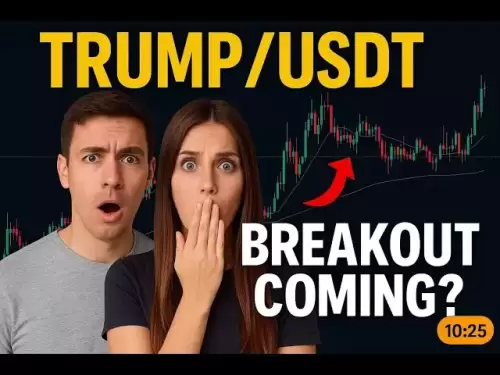-
 Bitcoin
Bitcoin $109,052.4381
3.52% -
 Ethereum
Ethereum $2,568.1745
3.41% -
 Tether USDt
Tether USDt $1.0004
0.01% -
 XRP
XRP $2.4023
2.46% -
 BNB
BNB $664.0401
2.94% -
 Solana
Solana $172.2897
3.28% -
 USDC
USDC $0.9999
0.00% -
 Dogecoin
Dogecoin $0.2320
5.12% -
 Cardano
Cardano $0.7659
4.51% -
 TRON
TRON $0.2726
0.58% -
 Sui
Sui $3.9704
2.57% -
 Chainlink
Chainlink $16.1221
3.68% -
 Avalanche
Avalanche $23.2414
4.91% -
 Hyperliquid
Hyperliquid $27.6603
5.99% -
 Stellar
Stellar $0.2933
3.83% -
 Shiba Inu
Shiba Inu $0.0...01480
3.20% -
 Hedera
Hedera $0.1989
2.42% -
 UNUS SED LEO
UNUS SED LEO $8.8520
1.14% -
 Bitcoin Cash
Bitcoin Cash $407.3539
5.26% -
 Toncoin
Toncoin $3.0936
1.51% -
 Polkadot
Polkadot $4.7610
3.44% -
 Litecoin
Litecoin $96.6773
2.94% -
 Monero
Monero $365.5787
4.76% -
 Bitget Token
Bitget Token $5.2493
2.40% -
 Pepe
Pepe $0.0...01394
8.36% -
 Pi
Pi $0.8141
9.95% -
 Dai
Dai $0.9998
-0.01% -
 Ethena USDe
Ethena USDe $1.0009
0.02% -
 Uniswap
Uniswap $6.3309
9.31% -
 Aave
Aave $254.6744
-3.32%
Must you sell when the MA crosses? How to avoid false signal interference?
Don't sell solely on MA crossovers; consider market context, volume, other indicators, and fundamentals to avoid false signals and make informed decisions.
May 21, 2025 at 10:56 am
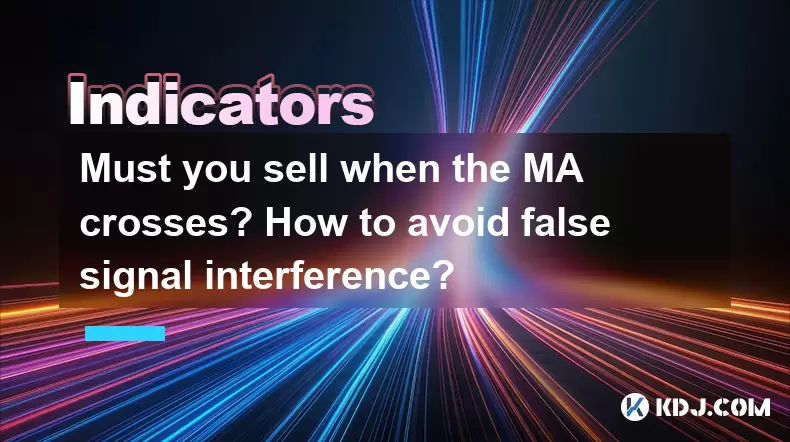
Must you sell when the MA crosses? How to avoid false signal interference?
In the world of cryptocurrency trading, the moving average (MA) is a popular technical indicator used to identify trends and potential entry or exit points. One common question among traders is whether they must sell when the MA crosses. Additionally, traders often struggle with false signals that can lead to premature or incorrect trading decisions. This article will delve into these topics, providing insights on when to sell based on MA crossovers and strategies to avoid false signal interference.
Understanding MA Crossovers
Moving averages are calculated by taking the average price of a cryptocurrency over a specific period. Common types include the simple moving average (SMA) and the exponential moving average (EMA). A crossover occurs when a shorter-term MA crosses above or below a longer-term MA, signaling potential trend changes.
When a short-term MA crosses above a long-term MA, it's often seen as a bullish signal, suggesting that the price may continue to rise. Conversely, when a short-term MA crosses below a long-term MA, it's considered a bearish signal, indicating that the price may decline. However, the decision to sell based solely on a crossover can be risky due to the potential for false signals.
Factors to Consider Before Selling on a Crossover
While MA crossovers can provide valuable insights, they should not be the sole basis for selling a cryptocurrency. Several factors should be considered before making a trading decision:
Market Context: Evaluate the broader market conditions. Is the entire market experiencing a downtrend, or is the specific cryptocurrency showing signs of weakness?
Volume: Check the trading volume around the crossover. A crossover accompanied by high volume may be more reliable than one with low volume.
Other Indicators: Use additional technical indicators, such as the Relative Strength Index (RSI) or the Moving Average Convergence Divergence (MACD), to confirm the crossover signal.
Fundamental Analysis: Consider the underlying fundamentals of the cryptocurrency. Are there any significant developments or news that could impact its price?
By taking these factors into account, traders can make more informed decisions and reduce the risk of selling prematurely based on a single MA crossover.
Strategies to Avoid False Signal Interference
False signals can lead to unnecessary trades and potential losses. Here are some strategies to help traders avoid false signal interference when using MA crossovers:
Use Multiple Timeframes: Analyze the MA crossover on different timeframes. A crossover that appears on multiple timeframes is generally more reliable.
Combine with Other Indicators: Use other technical indicators to confirm the MA crossover. For instance, if the RSI indicates an overbought condition alongside a bearish crossover, it may strengthen the sell signal.
Set a Confirmation Period: Wait for a certain period after the crossover to confirm the signal. This can help filter out short-term noise and false signals.
Monitor Price Action: Pay close attention to price action around the crossover. If the price quickly reverses after the crossover, it may be a false signal.
Implementing these strategies can help traders filter out false signals and make more accurate trading decisions.
Practical Example of Using MA Crossovers
To illustrate how to use MA crossovers effectively, let's walk through a practical example. Suppose you are trading Bitcoin and using a 50-day SMA and a 200-day SMA.
Identify the Crossover: You notice that the 50-day SMA has crossed below the 200-day SMA, indicating a bearish signal.
Evaluate Market Context: You check the broader market and see that other major cryptocurrencies are also showing signs of a downtrend.
Check Volume: The volume around the crossover is significantly higher than average, suggesting that the signal may be more reliable.
Confirm with Other Indicators: You consult the RSI and see that it's in an overbought condition, further supporting the bearish signal.
Consider Fundamentals: There are no significant positive developments in the Bitcoin ecosystem that could counteract the bearish signal.
Based on this analysis, you decide to sell your Bitcoin position. However, to avoid false signals, you:
Use Multiple Timeframes: You check the daily, 4-hour, and 1-hour charts and see the crossover on all three timeframes.
Set a Confirmation Period: You decide to wait for one more day to see if the bearish trend continues.
Monitor Price Action: You observe the price action closely and see that it continues to decline without significant reversals.
After confirming the bearish signal, you proceed with the sale.
Technical Analysis Tools for MA Crossovers
Several tools and platforms are available to help traders analyze MA crossovers and other technical indicators. Here are some popular options:
TradingView: A comprehensive platform that offers advanced charting tools, including customizable MA indicators and the ability to overlay multiple timeframes.
MetaTrader 4 (MT4): Widely used among forex and cryptocurrency traders, MT4 provides built-in MA indicators and the ability to automate trading strategies.
Coinigy: A cryptocurrency trading platform that offers real-time data and customizable charts, including MA indicators.
CryptoWatch: A platform focused on cryptocurrency markets, offering detailed charts and the ability to set up alerts for MA crossovers.
Using these tools, traders can effectively monitor MA crossovers and implement the strategies discussed earlier to avoid false signals.
Implementing MA Crossovers in Trading Strategies
Incorporating MA crossovers into a trading strategy requires careful planning and execution. Here are some steps to consider:
Define Your MAs: Decide on the specific MAs to use, such as a 50-day and 200-day SMA, or a 12-day and 26-day EMA.
Set Up Alerts: Use trading platforms to set up alerts for when the MAs cross, so you can act quickly on the signal.
Backtest Your Strategy: Before applying the strategy to live trading, backtest it using historical data to assess its effectiveness and identify any potential issues.
Monitor and Adjust: Continuously monitor the performance of your strategy and make adjustments as needed based on market conditions and performance.
By following these steps, traders can effectively integrate MA crossovers into their trading strategies while minimizing the impact of false signals.
Frequently Asked Questions
1. Can MA crossovers be used for both short-term and long-term trading?
Yes, MA crossovers can be used for both short-term and long-term trading. For short-term trading, shorter-term MAs such as a 5-day and 20-day SMA can be used to capture quick price movements. For long-term trading, longer-term MAs like a 50-day and 200-day SMA can help identify broader trends.
2. How do I choose the right MA periods for my trading strategy?
The choice of MA periods depends on your trading style and the specific cryptocurrency you are trading. Shorter periods (e.g., 5-day and 20-day) are more sensitive to price changes and suitable for short-term trading. Longer periods (e.g., 50-day and 200-day) are less sensitive and better for identifying long-term trends. Experiment with different periods and backtest your strategy to find what works best for you.
3. Are there any specific cryptocurrencies where MA crossovers are more effective?
MA crossovers can be effective for a wide range of cryptocurrencies, but they tend to work best with highly liquid assets like Bitcoin and Ethereum. These cryptocurrencies have more reliable price data and higher trading volumes, which can make MA crossovers more accurate.
4. How can I automate MA crossover trading strategies?
Many trading platforms, such as MetaTrader 4 and TradingView, allow you to automate MA crossover strategies using custom scripts or built-in tools. You can set up rules for buying and selling based on MA crossovers and let the platform execute trades automatically. However, it's important to monitor automated strategies closely and adjust them as needed based on market conditions.
Disclaimer:info@kdj.com
The information provided is not trading advice. kdj.com does not assume any responsibility for any investments made based on the information provided in this article. Cryptocurrencies are highly volatile and it is highly recommended that you invest with caution after thorough research!
If you believe that the content used on this website infringes your copyright, please contact us immediately (info@kdj.com) and we will delete it promptly.
- XRP Price Consolidates Near $2.40 as Spot ETF Listing Hopes Fade
- 2025-05-21 23:55:13
- Guatemala's Largest Bank Banco Industrial Adopts SukuPay's Stablecoin Rails for Remittances
- 2025-05-21 23:55:13
- Bitcoin crossed the symbolic threshold of $107500 this Wednesday
- 2025-05-21 23:50:13
- Pi Network (PI) Price Prediction: Will Bulls Prevent Excessive Price Drain?
- 2025-05-21 23:50:13
- Ethereum (ETH) Drops 2% as Cofounder Jeffrey Wilcke Moves 105,736 ETH to Kraken Exchange
- 2025-05-21 23:45:14
- After Recent Scandal, Crypto Buyers Watch These Cardano (ADA) Price Predictions
- 2025-05-21 23:45:14
Related knowledge
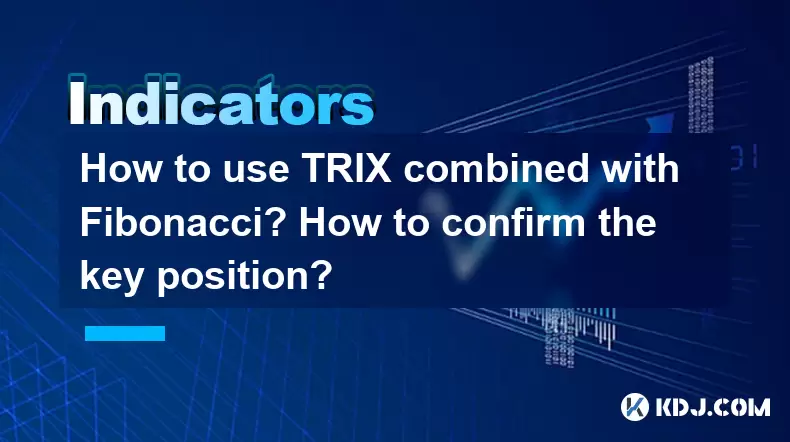
How to use TRIX combined with Fibonacci? How to confirm the key position?
May 21,2025 at 10:14pm
Introduction to TRIX and Fibonacci in Cryptocurrency TradingIn the world of cryptocurrency trading, technical analysis plays a crucial role in helping traders make informed decisions. Two popular tools in this realm are the TRIX (Triple Exponential Average) and Fibonacci retracement levels. TRIX is a momentum indicator that helps identify the trend's st...
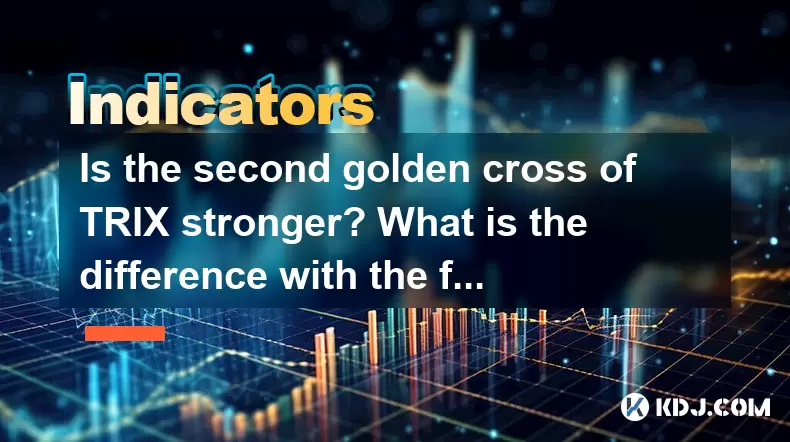
Is the second golden cross of TRIX stronger? What is the difference with the first golden cross?
May 21,2025 at 10:42pm
The TRIX (Triple Exponential Average) indicator is a momentum oscillator used in technical analysis to identify trends and potential buy or sell signals in the cryptocurrency market. One of the key signals traders watch for is the golden cross, which occurs when a shorter-term moving average crosses above a longer-term moving average. In the context of ...
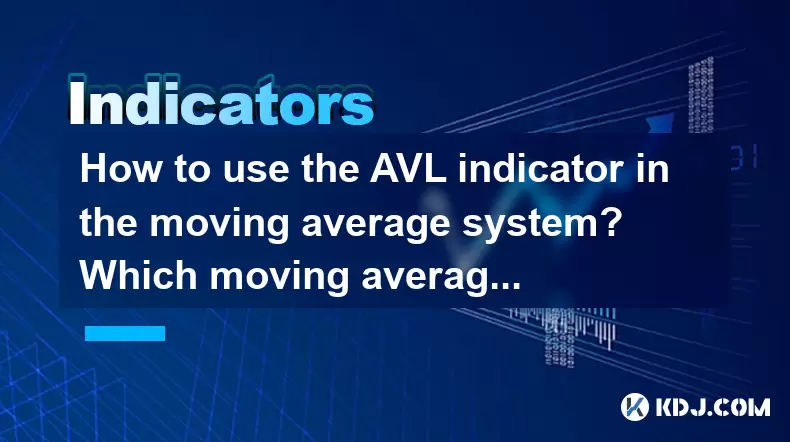
How to use the AVL indicator in the moving average system? Which moving average is the best?
May 21,2025 at 09:36pm
The AVL indicator, or Average Volume Level indicator, is a tool used in technical analysis to help traders understand the average trading volume over a specified period. When combined with a moving average system, it can provide valuable insights into market trends and potential entry and exit points. In this article, we will explore how to effectively ...
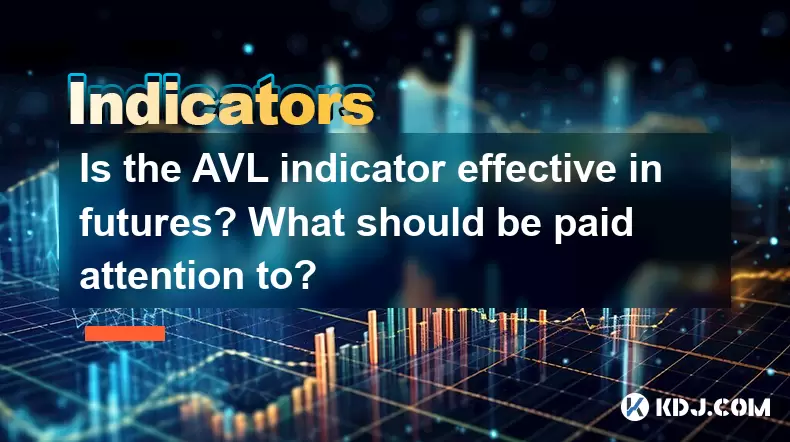
Is the AVL indicator effective in futures? What should be paid attention to?
May 21,2025 at 11:21pm
The AVL (Average Volume Line) indicator is a technical analysis tool used by traders in the cryptocurrency futures market to gain insights into market trends and potential price movements. This article will explore the effectiveness of the AVL indicator in futures trading and highlight key factors that traders should pay attention to when using this too...
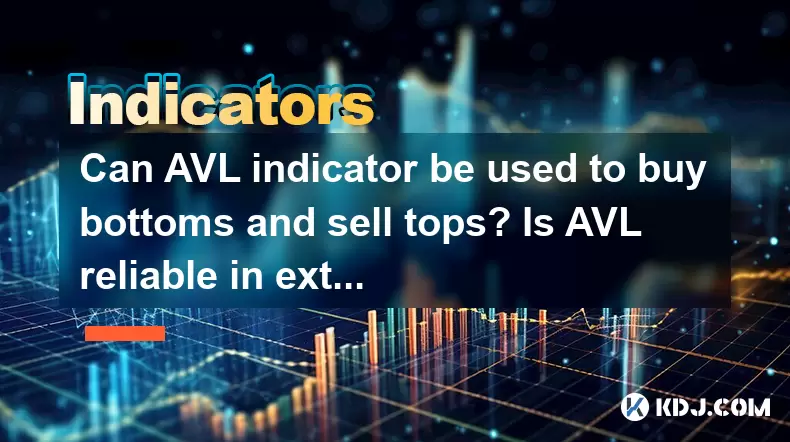
Can AVL indicator be used to buy bottoms and sell tops? Is AVL reliable in extreme market conditions?
May 21,2025 at 08:28pm
The Average Volume Line (AVL) indicator is a tool used by traders and investors in the cryptocurrency market to gauge the strength and direction of a trend based on volume. The question of whether the AVL can be used to buy bottoms and sell tops, and its reliability in extreme market conditions, is a complex one that requires a detailed exploration of i...
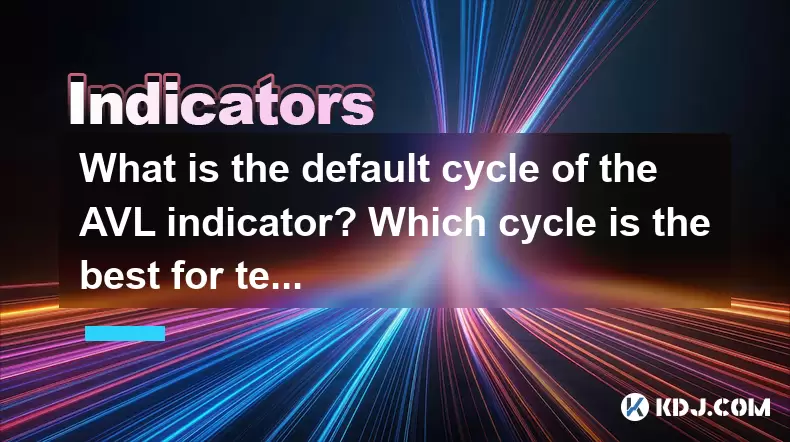
What is the default cycle of the AVL indicator? Which cycle is the best for testing?
May 21,2025 at 11:50pm
The Average Volume Line (AVL) indicator is a technical analysis tool used by traders in the cryptocurrency market to assess the volume trends over a specific period. Understanding the default cycle of the AVL indicator and determining the best cycle for testing are crucial for effectively utilizing this tool in trading strategies. Understanding the AVL ...

How to use TRIX combined with Fibonacci? How to confirm the key position?
May 21,2025 at 10:14pm
Introduction to TRIX and Fibonacci in Cryptocurrency TradingIn the world of cryptocurrency trading, technical analysis plays a crucial role in helping traders make informed decisions. Two popular tools in this realm are the TRIX (Triple Exponential Average) and Fibonacci retracement levels. TRIX is a momentum indicator that helps identify the trend's st...

Is the second golden cross of TRIX stronger? What is the difference with the first golden cross?
May 21,2025 at 10:42pm
The TRIX (Triple Exponential Average) indicator is a momentum oscillator used in technical analysis to identify trends and potential buy or sell signals in the cryptocurrency market. One of the key signals traders watch for is the golden cross, which occurs when a shorter-term moving average crosses above a longer-term moving average. In the context of ...

How to use the AVL indicator in the moving average system? Which moving average is the best?
May 21,2025 at 09:36pm
The AVL indicator, or Average Volume Level indicator, is a tool used in technical analysis to help traders understand the average trading volume over a specified period. When combined with a moving average system, it can provide valuable insights into market trends and potential entry and exit points. In this article, we will explore how to effectively ...

Is the AVL indicator effective in futures? What should be paid attention to?
May 21,2025 at 11:21pm
The AVL (Average Volume Line) indicator is a technical analysis tool used by traders in the cryptocurrency futures market to gain insights into market trends and potential price movements. This article will explore the effectiveness of the AVL indicator in futures trading and highlight key factors that traders should pay attention to when using this too...

Can AVL indicator be used to buy bottoms and sell tops? Is AVL reliable in extreme market conditions?
May 21,2025 at 08:28pm
The Average Volume Line (AVL) indicator is a tool used by traders and investors in the cryptocurrency market to gauge the strength and direction of a trend based on volume. The question of whether the AVL can be used to buy bottoms and sell tops, and its reliability in extreme market conditions, is a complex one that requires a detailed exploration of i...

What is the default cycle of the AVL indicator? Which cycle is the best for testing?
May 21,2025 at 11:50pm
The Average Volume Line (AVL) indicator is a technical analysis tool used by traders in the cryptocurrency market to assess the volume trends over a specific period. Understanding the default cycle of the AVL indicator and determining the best cycle for testing are crucial for effectively utilizing this tool in trading strategies. Understanding the AVL ...
See all articles























